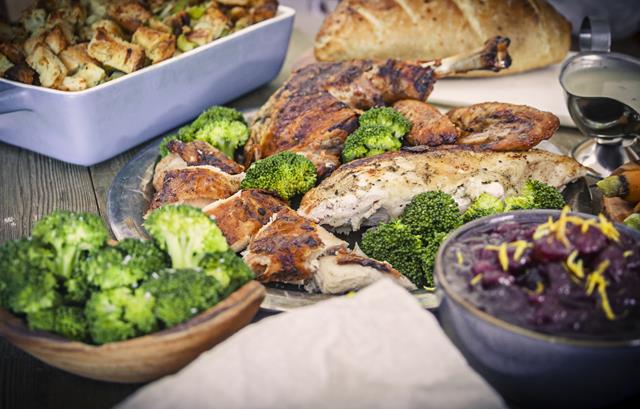With folks gathered around the table, amid all the fixings and side dishes, at the center of the Thanksgiving feast sits the turkey.
Cooking the perfect turkey is an art form. It can also be a time consuming endeavour in a crowded kitchen that is heating up from all the people within and the oven running all day.
But it doesn’t have to be. Make your backyard grill an extension of your holiday kitchen to alleviate some of the madness (and reduce the temperature). Slow roasted turkey on your barbecue’s rotisserie has the crispy golden skin you are accustomed to seeing out of the oven, with moist, tender meat infused with flavors that have a hint of smokiness from the open flame.
This Thanksgiving, Napoleon suggests trying its signature butter-injected turkey, grilled on the spit:
- Before turning on your grill, remove the cooking grates and place a drip pan under where the turkey will be cooking. Pour two cups of chicken stock into the drip pan.
- Turn on the rear rotisserie burner and pre-heat the barbecue to 325°F.
- Melt ¼ cup of butter, mix in 2 tablespoons of orange blossom honey and, using a marinade injector, and inject your honey butter into all of the meaty parts of the bird.
- Season the turkey skin with a healthy blend of coarse salt, fresh ground pepper and fresh herbs (sage, rosemary and thyme are best — especially if plucked from your own herb garden). Then truss the turkey to keep the wings and legs from flopping around as it spins.
- Insert the rotisserie rod and secure the forks, ensuring that the bird is balanced on the spit. Place the turkey onto the grill, turn on the rotisserie and let it go.
- Check in on it every 15 to 20 minutes, marinating with melted butter. (If it looks like the wings or legs are cooking too fast, wrap them in foil until the rest of the turkey is done cooking.) It is done cooking when the breast reaches an internal temperature of 150°F. Remove it from your barbecue, wrap in foil and cover with towels for 15 to 20 minutes before carving
For a gravy, remove the pan with the drippings and use a gravy separator to separate the turkey fat. In a saucepan, combine the fat with enough flour to make a paste. Then, slowly add the liquid strained from the drippings a little bit at a time until you have the perfect gravy consistency (if you need more liquid than you have drippings, use the water from the cooked the vegetables). Season to taste with salt and pepper.
For more information, please visit www.napoleon.com.
